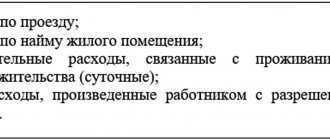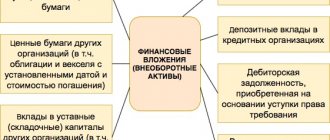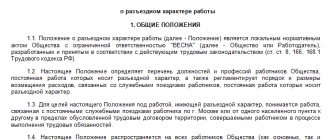The economic activities of organizations include a lot of actions, operations, types of communications and other aspects of daily routine. The management of an organization and its employees are faced with the need to resolve various issues and make management decisions every day. Some matters cannot be solved while at your workplace, sitting comfortably in an office chair at a computer. There is a need for trips and business trips, holding negotiations in other cities and even countries. This article discusses in detail the issue of the need for a business trip, its goals and examples, registration under current legislation, documentation requirements, as well as the features of trips in Russia and abroad. This article will also discuss who can be sent on a trip and what should be considered for business travel.
Business trip concept
This concept has a clear definition, which is prescribed in labor legislation. According to the Labor Code of the Russian Federation, a business trip is the direction of an employee by management on a trip with a specific task. At the same time, the destination is quite remote from the main place of work, the trip has a clearly formulated purpose, stated in the documents, and the time frame for its completion is limited. Registration of accompanying documents, reporting at the end of the trip, guarantees for the employee are regulated by labor and tax legislation. Possible purposes of the business trip are also spelled out, examples of which are presented below.
Who should write the job assignment?
This is usually the responsibility of the enterprise's human resources department. The document is signed by the head or his deputy. The employer issues an order stating:
- Purpose of the trip.
- Destination.
- Full name and position of the employee who is sent to carry out the assignment.
- Duration of the trip: period and specific dates.
- Amount of work on a business trip.
- Daily expenses.
- Job number in the log book.
The employee puts his signature on the order as a sign of familiarization.
Why do you need business trips?
When an employee goes on a business trip, management determines for him a clear task that he must complete during the trip. The task may concern various areas of the organization’s economic activity. Examples of business trip purposes include the following:
- concluding contractual relations for supplies or sales with contractors;
- negotiations on cooperation;
- resolution of disputes, conflicts and other issues related to the legal side of activities;
- purchase of equipment, raw materials and materials;
- business conferences, participation in gatherings and exhibitions related to the company’s activities;
- promoting goods in new markets, expanding the customer base;
- participation in research projects related to the company’s activities;
- staff development;
- research of sales markets, competing organizations and other marketing issues;
- setting up equipment, software and working with other technical issues in subsidiaries or divisions;
- Conducting inspections of the operation of the branch network and divisions.
Legislative framework: 7 examples of wording
The main document regulating the procedure for going on a business trip is Government Decree No. 749. It defines the procedure for processing documents, counting deadlines, marks at the border (when leaving and entering the country), etc. However, specific statements of goals are not presented in this regulatory act.
Therefore, the organization itself can determine these goals and approve them in internal documents (for example, in the Travel Regulations). The document contains standard sections:
- general provisions;
- order of referral;
- the duration of the business trip and the procedure for its extension;
- recall of an employee from a trip;
- employee guarantees;
- procedure for payment of travel allowances.
Here you can clarify the purpose of the trip, i.e. write down specific examples of what the purpose of a business trip might be for a director:
- Conducting negotiations with partners and contractors (indicate the names of organizations and full names, positions of representatives), offering them cooperation, discussing the terms of signing an agreement.
- Conducting negotiations with potential partners, searching for new clients and counterparties for the development of the company.
- Launching a new business project, opening a branch, representative office.
- Carrying out an inspection of a branch or separate division, an audit of accounting, other departments, an inspection to eliminate violations discovered during the inspection by regulatory authorities (specify which ones).
- Conducting negotiations on the purchase of raw materials, inventory items, purchasing materials, conducting settlements with counterparties.
- Exchange of experience, participation in a training event, completion of a course.
- Taking part in a market research event for a specific city or region.
Note! The above are only general examples of wording. To properly prepare the documents, you can take any of them and specify them, for example: “Negotiations with the general director of Vintage LLC to sign a framework agreement on cooperation” or “Taking part in studying the sales market of Yekaterinburg.”
What cannot be considered a business trip
Not every employee trip can be considered a business trip. Registration of a business trip is illegal in the following situations:
- lack of official registration of an employee in the organization, no concluded employment contract, no entry in the work book;
- the employee’s employment contract specifies the traveling nature of the work;
- the employee is a freelance worker who does not have a specific permanent place of work.
Types of trips and their timing
Corporate mission trips can be classified according to different characteristics. Thus, on a territorial basis, trips within the territory of the Russian Federation and to foreign countries are distinguished. According to the duration of business trips, short-term and long-term trips are distinguished. According to the composition of the travelers - group and single. There may also be planned and unscheduled business trips.
To date, there are no clear guidelines in the legislation regarding the timing of the trip. There are no minimum or maximum restrictions. The management of the organization independently determines the complexity of the task and the time required to complete it. Previously, there were restrictions. It was believed that the maximum duration of a business trip could not exceed forty days. In construction, the maximum threshold for a business trip reached a year.
How to write a business trip report - example and formatting rules
A business trip report is a sample document drawn up in any form, which is approved by a local act for the enterprise. Each organization determines the need to use it in practice independently. Since 2015, again, you can do without this form.
If you decide that you need a business trip report, an example of its structure should contain several blocks:
- details of the document indicating the place of its preparation, date and registration number;
- the period for which the trip report form is filled out;
- the reason that served as the basis for sending on a business trip;
- tasks that had to be completed during a business trip;
- achieved results (it is better to describe them in as much detail as possible).
When filling out a business trip report, the writing example may contain a concise summary of the results of the trip or a more detailed disclosure of the current situation. Sometimes the allocated space to reflect the results is not enough. In this case, you are allowed to attach a blank A4 sheet and continue presenting the information on it.
A business trip report, a sample of which is being developed by the enterprise, is needed to justify the need for a specific business trip to regulatory authorities. It is for this purpose that detailed answers are given about the results of the trip. If the set goal was not achieved, then the trip report must contain an explanation of the reasons that served as an obstacle to completing the task.
Legal requirements and regulation
Travel issued as a business trip is subject to certain legal requirements. Business trips are regulated by the Labor Code of the Russian Federation and the Tax Code of the Russian Federation. In the Labor Code, regulations regarding these work processes are described in Articles 166, 167, 168. They reveal a number of questions that may arise when completing this procedure: what can be considered a business trip, guarantees for the employee, as well as questions about reimbursement of expenses during the trip.
The Tax Code describes information on how to reflect travel expenses in accounting, what can be written off, and from what amounts payments are made to the social insurance funds of citizens. There are also separate resolutions containing the most complete information about amendments made to legislative acts, accounting innovations and meeting the requirements of regulatory authorities. You can find all this information in the following documents: Resolutions No. 749, 729, 812, 64.
What is guaranteed to the employee
Guarantees for an employee do not depend on the purpose of the business trip; there can be many examples. But with any of them, the employer bears some obligations to the employee. An employee who is sent on a business trip is provided with the following guarantees:
- preservation of position, workplace, average daily wage;
- payment for days off spent on a business trip at double the rate;
- reimbursement of expenses that may arise during a business trip in Russia and abroad, including obtaining a foreign passport, obtaining a visa, customs duties and other fees.
All these guarantees are prescribed in labor legislation and are subject to mandatory compliance by the employer.
Who to send on a business trip
The choice of an employee to go on a trip depends on the purpose of the trip, examples of work assignments, its duration and the severity of the expected conditions. Different reasons for travel require specific knowledge and skills from the employee.
Thus, the execution of a supply agreement must be entrusted to a person savvy in business negotiations and diplomacy. This may be a specialist whose job responsibilities include procurement, planning and calculating the budget for business relations with suppliers, or a person who can competently explain his position and achieve optimal conditions in the concluded supply agreement.
If the purpose of the trip is to set up equipment or software, knowledge of office work and ordinary human charisma are not enough for the sent employee. An official with a technical background is sent on such a trip. The same situation occurs when conducting on-site inspections and audits. An accountant or economist should be sent on such a trip.
Who is prohibited from being sent on business trips?
In addition to the human factor, questions about the qualifications and personal abilities of candidates, there is another aspect in choosing an employee for a work trip. There are legal requirements regarding categories of citizens who cannot be sent on business under any circumstances. These include the following groups of people:
- minor employees, interns, interns;
- pregnant women;
- employees of the company working under an apprenticeship contract (except for business trips for the purpose of training);
- participants in election campaigns, candidates for political positions;
- people whose capabilities are limited by illness.
There are also groups of people who can be sent on a business trip only if their written consent is obtained:
- women with small children (up to three years of age);
- a single parent raising a child under five years of age;
- guardians of children under the age of majority;
- an employee whose family has a dependent in need of constant care.
Which employees can be sent on business trips?
Since the employee must be paid the average salary for all days of the trip for the purpose set by the employer and not inconsistent with the performance of his official duties, it is clear that the person must have an employment relationship with the organization sending him on a business trip (clause 2 of Resolution No. 749 ).
Any employee included in the organization’s staffing table, hired under an employment contract (not to be confused with civil contracts), if initially the conditions for performing job duties do not require traveling (couriers working on a rotational basis), can be sent on a business trip.
It is important to consider that a certain category of people cannot be sent on business trips at all, according to labor legislation:
- pregnant workers;
- employees who have entered into a student agreement with the organization;
- working youth (up to age eighteen);
- persons who are running for elective office in upcoming elections.
Also, the legislator requires written consent if it is necessary to travel outside the place of residence in order to fulfill the production tasks of employees who have certain benefits:
- mothers with children under three years of age;
- women or men raising a child under five years of age without a second spouse;
- workers with disabled children or caring for sick relatives (if there is a conclusion about the need for outside care);
- employees with a working disability group and working in certain conditions.
Business trip arrangements
In order for a business trip to be taken into account in tax, accounting and management accounting, it is necessary to formalize it correctly. First of all, a business trip assignment is drawn up, dates and deadlines are set. The travel candidate must familiarize himself with the document drawn up and give his consent or refusal in writing.
If the answer is positive, the manager issues an order to send the specialist on a business trip. The employee is issued and issued a travel certificate and a work assignment. Upon completion of the trip, the traveler must provide a progress report and expense report with supporting receipts, receipts, and tickets.
Since 2021, a change has been made to the legislation, according to which the issuance of a certificate and official assignment is no longer mandatory. Instead, they use a memo. But many organizations continue to draw up these documents for internal accounting purposes.
When using personal or corporate vehicles, a memo and a waybill are required, as well as a power of attorney and other documents confirming the legality of using a particular vehicle.
How to formulate the purpose of an employee’s trip
When sending an employee on a business trip, it is necessary to formulate its purpose. A business trip is the purpose of the trip. The abolition of the mandatory registration of not only travel certificates, but also official assignments, as well as the generation of reports for employees returning from business trips, is regulated by:
- new edition of the Regulations on the specifics of sending on business trips (approved by Decree of the Government of the Russian Federation of October 13, 2008 No. 749).
- Decree of the President of the Russian Federation dated December 12, 2014 No. 765 (approved by Decree of the President of the Russian Federation dated July 18, 2005 No. 813).
Taking this into account, today a travel certificate, as well as an official assignment for a business trip, are not considered mandatory primary documents. Previously, without them, organizations could not accept and record all expenses incurred by an employee as expenses when calculating income taxes. Now the employer has the right to formulate the purpose of the trip orally.
Despite such innovations, a business trip assignment is still issued if it is necessary to clearly formulate the purpose of the trip, delineate obligations, and establish a list and scope of work during the employee’s work away from the main organization. The tasks will also help during reporting, when you need to justify writing off expenses incurred in accounting.
After the cancellation of travel certificates and assignments, the main documents in this area became the regulations and orders on sending an employee on a business trip. The purpose and duration of the trip are reflected in the order, and the actual duration of the trip is recorded using travel documents.
Order to send an employee on a business trip with expert comments
View sample
Official assignment for a business trip: is it mandatory or not to fill out?
Despite the fact that the mandatory registration of official assignments for business trips has been cancelled, many organizations still continue to document the purpose of the trip in writing. HR officers are guided by a sample job assignment for sending on a business trip.
This approach allows not only to optimize document flow in general, but also to systematize documents and arrange them in a unified format. It is rational to prescribe the procedure for processing and general maintenance of documents in the company’s internal local regulations.
Information in documents
The memo is drawn up in free form, but there are a number of details that must be indicated: the dated period of the business trip, information about the transport used, the goals set for the employee and the results of their implementation.
All expenses incurred by the employee during the trip must be indicated in the advance report. This requirement applies to absolutely all types of expenses, including housing, transportation, fuel costs, food and others. In order to confirm the costs of paying for housing, it is necessary to provide to the accounting department at the end of the trip a check, receipt or receipt containing information about the lessor, the cost and rental period of the residential premises.
A management order must be issued accordingly. In office work, there is a unified form No. T-9, but the organization is not obliged to use it exclusively. The accounting policy of a particular organization may specify its own document form. You can also take advantage of the opportunity to create an order in free form. The main condition is that it contains the following data:
- the name and details of the organization that sent the employee on the trip;
- information about the employee;
- dates of the order;
- start and end dates of the travel period;
- tasks for the employee, purpose of the trip.
What documents to prepare
It is very convenient when an organization employs a specialist who knows how to arrange a business trip. But in times of massive layoffs, many small business owners have to do their own accounting and most of the official paperwork.
Private entrepreneurs and employees who have not completed accounting courses, if necessary, are interested in how travel allowances are processed.
It is no secret that this procedure includes several stages.
1. The head of the company issues a business trip order in the T9 form. He contains:
- FULL NAME. employee;
- his personnel number;
- job title;
- division of the company (department, sector, department) in which the employee works;
- goals and objectives of the trip, its timing, sources of financing (usually employer funds);
- destination.
A document is attached to the order - the basis for the business trip (memo or invitation).
Until 2013, it was also necessary to prepare a job assignment and a travel certificate. These forms are no longer required to be filled out. The labor costs of accountants have been reduced, but new questions have arisen: how to confirm the fact of a trip for official reasons and how to prove that the purpose of the trip has been achieved?
In this regard, many organizations continue to issue travel certificates to employees. This is a small and at the same time very informative document. The purpose on the travel certificate is the same as on the order.
2. The employer purchases travel tickets and books a hotel room.
3. The posted employee signs that he has read the order, receives travel tickets and information about his place of residence.
4. Daily allowances are calculated. According to the law, they are:
– 700 rub. per day – when traveling within the territory of the Russian Federation.
– 2500 rub. per day – for foreign business trips.
The employer may, on his own initiative, increase payments, but in this case he will be obliged to contribute to the budget the personal income tax accrued on amounts exceeding the specified values.
5. The employee’s salary is calculated for the period of his stay outside the place of his main duty. It is the average daily earnings multiplied by the number of days of a business trip. If the time spent on a business trip falls partly on weekends or holidays, the salary for that day is calculated at double the rate.
6. Upon returning from a trip, the employee fills out an advance report on expenses incurred in Form No. AO-1 and attaches supporting documents: travel tickets, a voucher for hotel accommodation, a waybill, checks for payment of fuel and lubricants, if necessary.
7. Summing up: was the purpose of the trip achieved? The employee prepares a written report or submits documents confirming the fact that the official task has been completed.
Example of a business trip assignment
The more important the task, the more levels it contains. The more a company invests in a business, the more results it aims to achieve. Not necessarily all the small details that the manager wants to know will be indicated in the order. Some of them can be discussed orally at meetings and when briefing the traveler. But, most likely, the employee will have to report on all points following the trip, even those that were not officially stated, but were announced orally. For clarity, we give an example of a job assignment below.
For example, let’s take the goal - “Concluding a supply agreement, advertising products.” For ease of reflection, we use the type of document generated by the 1C program. You can find it in personnel records, Form No. T-10a. This form contains 11 columns to fill out: structural unit, specialist position, country, city and organization to which the employee is sent, start and end date of the business trip, number of calendar days in total and excluding travel time, paying organization, basis, content tasks and a brief report on its completion. The document is signed by the head of the structural unit, the head of the organization and the employee himself.
The order contains travel information as follows:
- Last name, first name, patronymic of the employee and his personnel number: Sorokin Dmitry Evgenievich, 1 (personnel number in a separate window, according to personnel records).
- Structural unit: Marketing and Advertising Department.
- Position (specialty, profession): Leading marketer.
- Place of business trip (country, city, organization): Russia, Moscow, Realizator LLC.
- Basis (document, number and date): Service assignment No. 3 dated January 13, 2018
At the end of the order there are signatures of the manager and employee. The employee’s signature is placed opposite the inscription that he has read the order.
Mandatory advance report
In addition to reporting on the results of the business trip, the employee will also have to report on the expenses incurred. Let us remind you that when sending specialists, the employer is obliged to pay an advance on travel expenses.
This advance is paid for:
- Payment for travel to the place where the work assignment is performed.
- Renting accommodation for accommodation on a business trip. For example, paying for a hotel room or renting a room or apartment in the private sector.
- Resort fee, if the employee is sent to the territory of the Russian Federation, for a stay there you will have to pay a resort fee.
- Per diem expenses that compensate for the inconvenience associated with an employee living outside of their primary place of residence.
- Other expenses as agreed with the manager. For example, purchasing teaching aids, paying for certificates, and other services.
Please note that when submitting an advance report to the accounting department, you will also have to submit supporting documents: checks, receipts, tickets, invoices and other documents.
01/08/2019 Unified form No. T-10 “Travel certificate” and No. T-10a “Office assignment for sending on a business trip and a report on its implementation” were approved by Resolution of the State Statistics Committee of the Russian Federation dated 01/05/2004 No. 1 “On approval of unified forms of primary accounting documentation for labor accounting and payment." They are unified forms of primary accounting documentation for recording labor and its payment (for personnel accounting). Instructions / recommendations for filling out the form (Extract from the Post. Goskomstat of the Russian Federation dated January 5, 2004 No. 1): Travel certificate (form No. T-10) It is a document certifying the time spent on a business trip (time of arrival at the destination(s) and time of departure from it(es)). At each destination, notes are made on the time of arrival and departure, which are certified by the signature of the responsible official and seal. Issued in one copy by an employee of the personnel service on the basis of an order (instruction) to be sent on a business trip (Form N T-9). After returning from a business trip to the organization, the employee (accountable person) draws up an advance report (Form N AO-1) with documents attached, confirming the expenses incurred. The official assignment for sending on a business trip and the report on its implementation (form No. T-10a) is used to formalize and record the official assignment for sending on a business trip, as well as the report on its implementation. The official assignment is signed by the head of the structural unit in which a posted worker is working. It is approved by the head of the organization or a person authorized by him and submitted to the personnel service for issuing an order (instruction) on sending on a business trip (Form N T-9 or N T-9a). An employee who has arrived from a business trip draws up a short report on the work performed for travel period, which is agreed upon with the head of the structural unit and submitted to the accounting department along with a travel certificate (Form N T-10) and an advance report (Form N AO-1).
Subtleties of design
If for some reason an employee does not provide supporting documents about expenses (checks, receipts), the organization does not reimburse him for these expenses. Therefore, during a business trip, it is so important not to forget about reporting. Even a trip in a taxi or bus must be confirmed by a travel ticket or a receipt from the driver.
An important point is also to indicate the structural unit of the organization and the purpose of the trip. Depending on the specified data, further costs will be written off in accounting and tax accounting. So, if the purpose of the business trip was to repair machine tools, when carrying out accounting calculations, the amount of expenses will be written off as depreciation of the repaired equipment. If the goal was to conclude an agreement, the write-off will take place as general business expenses.
And the last point is a business trip with an unfulfilled goal. In most cases, expenses for such a trip are not recognized by the tax service and do not reduce the tax base. You can try to defend your case in court, but in most cases the law remains on the side of the Federal Tax Service.








